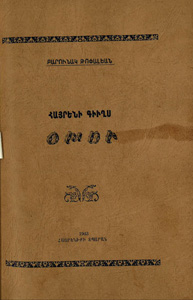Khatchig Mouradian, Armenian and Georgian Specialist, Near East Section, African and Middle Eastern Division
The destruction of the Ottoman Empire’s Armenian population during World War I severed the connection of survivors and their descendants from their ancestral homes in what is today the Republic of Turkey. Scattered around the globe, Armenians strove to keep the memory of their hometowns alive in the minds of subsequent generations. The literary genre of the hushamatean(memorial book) emerged as an enduring legacy of this effort.

More than 200 titles and many specialized periodicals dedicated to Armenian-populated regions, towns, or villages in the former Ottoman Empire have been published in the post-genocide Armenian Diaspora and in Armenia during the decades since, primarily in Armenian and English. Most are available at the Library of Congress. Many manuscripts remain unpublished, such as the ones about the village of Behesni (Besni) which are available in the Library’s African and Middle Eastern Division.
Aintab (Gaziantep), for instance, is featured in half a dozen memorial books, including Kevork Sarafian’s two-volume, 2,000-page “History of Aintab Armenians”; and a 327-page English-language version by the same author, titled “A Briefer History of Aintab,” published in 1953 and 1957 respectively. The Armenian-language periodicals Armenian Aintab and New Aintab, published in the 1960s and 1970s, were yet additional rich resources on Aintab and its Armenian survivors scattered around the globe. The National Library of Armenia recently digitized the two periodicals: Armenian Aintaband New Aintab.

Even tiny villages sometimes have entire volumes dedicated to them. Okhu (Bulgurcuk), a village in the region of Palu, comprised of a mere 25 Armenian households pre-WWI, yet one of its villagers wrote a 181-page memorial book about it.
Memorial books offer a window into the history, demography, culture, customs, genealogy, trades and crafts of the region they cover. They often feature dozens of photographs and maps. Misak Keleshian’s book on Sis (Kozan), published in Beirut in 1949, includes three maps and some 200 images.
Naturally, compiling these volumes required years of research and outreach by their authors and editors. “Sometimes, I had to read an entire volume to compile a one-page biography. Let me say, however, that it was easier to concern oneself with the dead than the living. For example, to receive the biography of a teacher living in Syria, I wrote three letters and … received it after four years,” writes Antranig Poladian in the introduction to his memorial book on Arabkir, published in New York in 1969.
But the authors of memorial books persevered despite challenges. The rewards were far greater for their successors, who they believed were otherwise condemned to forget their homeland and acculturate. Keleshian’s angst is palpable in the introduction. He writes, “Another decade or two, with the disappearance of the elders who remember our birthplace, narrators of its beauty would no longer have existed. And our children and grandchildren, headed in a direction away of homeland and memory, left to the mercy of the wings of fortune, surrendered to the all-consuming floods of foreign shores, would have to prepare for the permanent loss of traditions…. Consumed by the aim of preempting this horrible disaster, we got to work and made an effort to instill among Armenians, and particularly among the people of Sis, the love of their birthplace…” (Keleshian, 1949, p. VI)

Manuk Jizmejian, the author of a memorial book on Kharpert (Harput) entreats his readers not to forget Kharpert, which awaits “its children scattered around the world to return, rebuild, and make it flourish for the benefit of civilization.” (Jizmejian, 1955, p. 11)
Memorial books were often also treated as precious artifacts connecting families to a lost homeland. Arshag Alboyajian writes in the introduction to his memorial book on Gesaria (Kayseri) that every Armenian who hails from Kayseri, whether or not they can read Armenian language books, will desire to have it in their house, likening the memorial book to the ornate urn carrying the remains of one’s ancestors. (Alboyajian, 1937, p. VI)
Today, memorial books continue to adorn bookshelves and bookmarks of Armenians around the world, and constitute a tremendous resource for historians, ethnographers, demographers, and those interested in genealogy and family histories. The Armenian Church Catholicosate in Antelias, Lebanon, has in recent years republished a number of memorial books with additional editing and indexes.

For reference assistance about the Library’s Armenian memorial book collection, contact the African and Middle Eastern Reading Room at (202) 707-4188 or via Ask a Librarian.
Learn More:
Alboyajian, Arshag. “Պատմութիւն Կեսարիոյ” (History of Gesaria). Cairo: H. Papazian Press, 1937.
Jizmejian, Manuk. “Խարբերդ եւ իր զաւակները” (Kharpert and its children). Fresno, 1955.
Minassian, Mihran. “Tracking Down the Past: The Memory Book (‘Houshamadyan’) Genre – A Preliminary Bibliography,” Houshamadyan, January 17, 2014.
Keleshian, Misak. “Սիս-Մատեան” (Sis-matean). Beirut: Hay Djemaran Press, 1949.
Poladian, Antranik L. “Պատմութիւն Հայոց Արաբկիրի” (History of the Armenians of Arapkir). New York: Baikar Press, 1969.


İlk yorum yapan siz olun